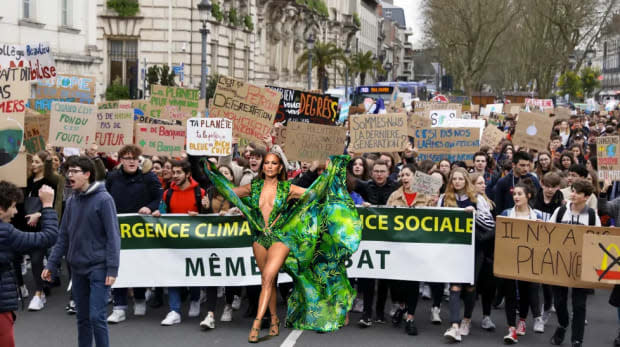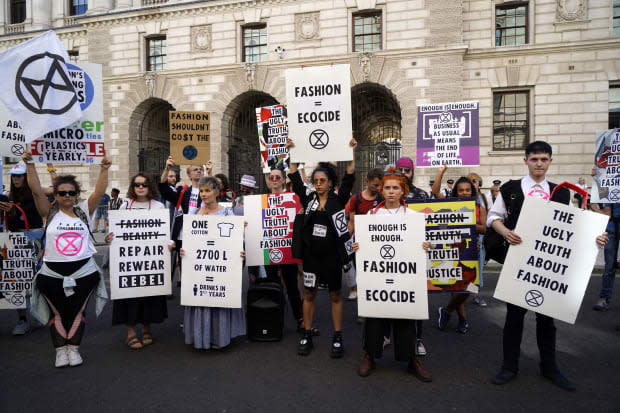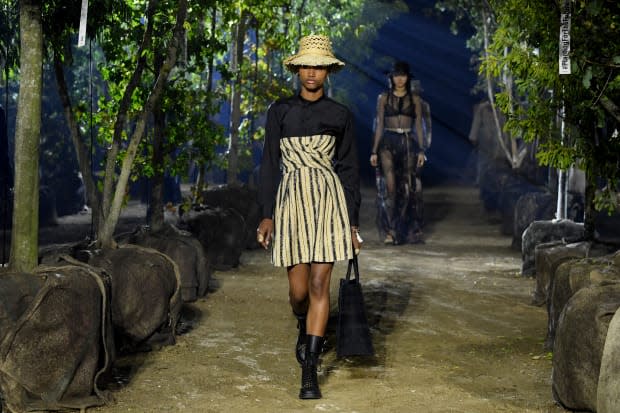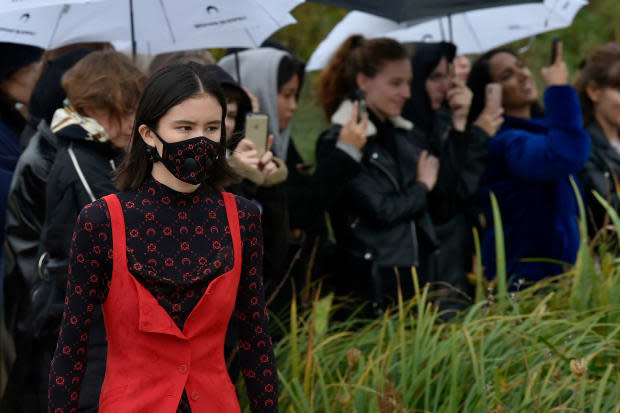Did Designers Finally Get the Climate Crisis Memo This Fashion Month?
The overlap of fashion week, climate strikes and a UN summit made for a unique conversation this season.

If there is any one image that sums up the past month on the internet for me, it's this collage by French writer and artist Thomas Lélu. Lélu photoshopped Jennifer Lopez's viral moment closing the Versace show in the "jungle print" dress against a backdrop of French climate strikers, so that it looks like the entertainer is leading a group of young protestors as they carry cardboard signs about deforestation and climate breakdown through the streets.
The collage, originally shared on Instagram, perfectly encapsulates a tension between the fashion hype machine and the industry's environmental impact that felt deeper than ever this season. If climate change used to be considered the exclusive purview of niche sustainable labels and a few bigger players like Stella McCartney, that divide became harder to maintain when runway pictures were sandwiched between images of the largest climate strike in history and Greta Thunberg reprimanding world leaders in our social media feeds.
So did the broader fashion industry catch on to the urgency of the climate conversation this season?
In New York, the answer was mixed. Collina Strada delivered a moving plea to be kinder to the Earth through her show, and labels like Chromat, Zero + Maria Cornejo, Gypsy Sport and relative newcomer Rentrayage all made use of sustainable alternatives to conventional materials. Gabriela Hearst claimed to hold the first carbon-neutral fashion show. There was a sustainability talk on the official CFDA schedule.
But these were mostly the same voices that have foregrounded sustainability in the past, and there weren't many new ones joining their chorus. Despite the declaration from some insiders that NYFW was "fun again" this season, that fun was somewhat predicated on ignoring the warming of the globe.
Related Articles
Fashion Brands Are Claiming to Be 'Carbon Neutral' — but Is It Greenwashing?
The Next Wave of Sustainable Fashion Is All About Regenerative Farming
Despite Much Fanfare, Nike's New 'Move to Zero' Sustainability Campaign Falls Short
Activist group Extinction Rebellion did more than any one designer could to make sure that London Fashion Week didn't overlook climate change. The group, also known as XR, suggested that the British Fashion Council shut down the festivities and host an assembly with industry leaders to discuss climate solutions instead. Their demand was not met, so XR staged a "die-in," complete with fake blood in front of show venues, carried signs declaring "There's No Fashion On A Dead Planet," and performed a "funeral" declaring LFW dead.

A panel featuring an XR representative, journalist Tamsin Blanchard, designer Phoebe English and other experts on the intersection of fashion and the environment was also part of the week's festivities, and designers like Patrick McDowell relied heavily on upcycling in their collections. Christopher Kane showed an "ecosexual"-themed collection that he claimed was for "people who love the planet." Pieces included a sweater with a picture of the globe on it. But ecological concerns regarding clothing fabrication were apparently not worth addressing in the designer's mind — no information was made available about the environmental impact of the materials used in the collection.
In Milan, the Green Carpet Fashion Awards spearheaded by EcoAge once again honored leaders in sustainability. An exhibition at the 10 Corso Como outlet spotlighted sustainable designers. Missoni gifted attendees solar-powered lamps accompanied by a card saying "we are at a crucial point for our planet and we need to take action." Gucci claimed to put on a carbon neutral show, while Bally promised that the wood from its presentation set would be recycled and the greenery re-planted.
Despite the plethora of plant prints in the Versace collection that ended with Jennifer Lopez in the iconic "jungle print" dress, that show — undoubtedly the most buzzy of the week in Milan — did nothing to address fires in the Amazon rainforest or other ecological nightmares that have been making the news.
Then came Paris. There, Dior used trees as a backdrop that it promised would be planted throughout the city at the close of the show and Stella McCartney presented what she claimed was her "most sustainable collection yet" featuring 75% eco-friendly fabrications. Marine Serre launched a memorable collection with a show centered around an apocalypse brought about by "climate wars, heatwaves and mass extinction" that featured plenty of upcycled materials. Miu Miu and Louis Vuitton let showgoers know that the wood from their sets would be donated, and Alexander McQueen's Sarah Burton featured upcycled materials from seasons prior in her Spring 2020 collection.

All of this did amount to the sense that more brands than usual were paying attention to what's happening to the environment. And there's something to be said for that — it wasn't long ago that you could count on one hand the number of shows that gave even the slightest nod in that direction.
The particular focus on the wastefulness of runway shows themselves, including their elaborate sets, felt especially new. But so many brands focused on minimizing set waste without doing much to address the actual environmental impact of their clothing manufacturing, even though the supply chain usually makes up something like 90% of a brand's footprint. It made one wonder whether the brands were displaying a real care for the Earth or whether they were just trying to avoid the kind of backlash Saint Laurent received after its environmentally irresponsible menswear show this summer.
And the moments when designers looked to nature for "inspiration" — think Christopher Kane's "ecosex" or Versace's viral "jungle print" dress — while totally overlooking the fashion industry's direct impact on nature felt like missed opportunities. They seemed to underscore the fact that many insiders still haven't fully grasped the connection between the fashion industry and its outsized environmental impact.
That's ultimately the problem: Fashion may be catching on to the fact that talking about the environment is en vogue. But the degree of urgency reflected in the climate strikes, activist movements and scientific reports was largely lacking on the runway.
Think about how many designers launched politically-charged shows after Donald Trump was elected or when Brexit was first up for discussion. Those were responses born of the industry anticipating the massive ramifications these political realities would have for their lives and businesses. If we understood that climate breakdown is going (and has already started) to alter our societies and futures far more dramatically than a Trump presidency ever could, why isn't our industry focusing its greatest creative talent on responding to that?
At least in the case of Trump or Brexit, fashion folks could claim that the industry wasn't directly to blame for the problem. Not so with climate change: The fashion industry plays a not-negligible role, as it contributes more carbon to the atmosphere than all international flights and maritime shipping combined, according to the UN. And despite the increasing buzz around circular design and upcycling, the fashion industry isn't implementing sustainability strategies quickly enough to keep up with its own growth, according to the Global Fashion Agenda's 2019 "Pulse of the Industry" report.
In short: Even in a season when sustainability was more of a focus than ever before, it was still so far from being enough. If there was a time when brands deserved applause for sustainable micro actions, that time was years ago, before we'd passed the mark for the maximum amount of carbon that we could safely live with in the atmosphere. Now is the time for decisive changes that correspond to the magnitude of the problem.

For all its shortcomings, though, this season did contain some of the blueprints for what an appropriate response to the climate crisis might look like in the future. Brands like Marine Serre and Stella McCartney proved that fashion's power for compelling storytelling can be harnessed to communicate truths about our warming planet's fate in an impactful way, while understanding the old art school adage that "the medium is the message" — in other words, no Earth-centric runway theme makes sense if it's not backed by clothes made in the most environmentally-conscious way.
Labels like Gypsy Sport and Chromat offered us a vision of sustainability that makes room for all races, genders, sizes and sexualities. Activists like those at Extinction Rebellion challenged us to question the status quo that's defined our industry for so long. And for all the potential problems with reaching "carbon neutrality" by way of purchased carbon offsets, Gucci and Gabriela Hearst's commitments at least displayed a level of understanding that fashion brands need to decarbonize as quickly as possible.
If the industry can build on these lessons, perhaps fashion week could become the kind of gathering that advances, rather than trails behind, the climate conversation. Let's hope we can figure out how to get there before it's too late.
